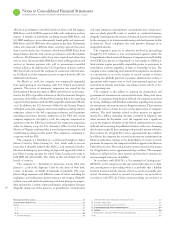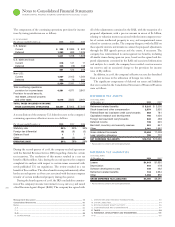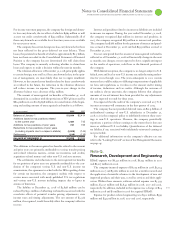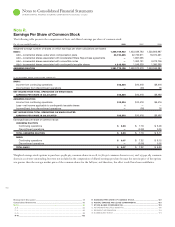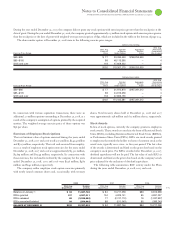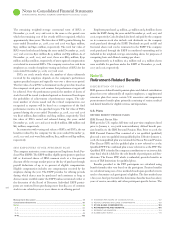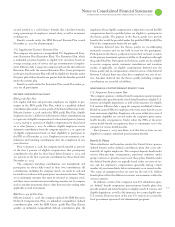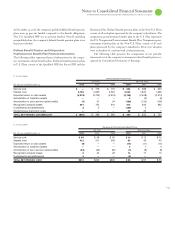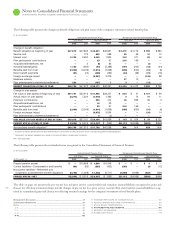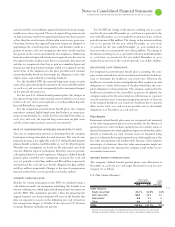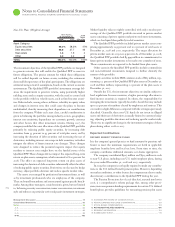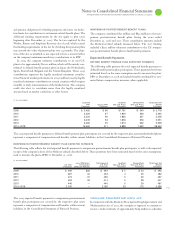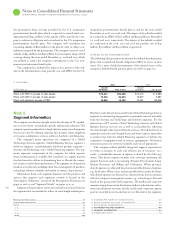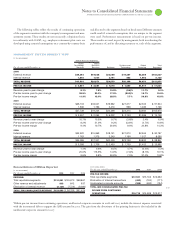IBM 2008 Annual Report Download - page 109
Download and view the complete annual report
Please find page 109 of the 2008 IBM annual report below. You can navigate through the pages in the report by either clicking on the pages listed below, or by using the keyword search tool below to find specific information within the annual report.
Notes to Consolidated Financial Statements
INTERNATIONAL BUSINESS MACHINES CORPORATION and Subsidiary Companies
second method is a cash balance formula that calculates benefits
using a percentage of employees’ annual salary, as well as an interest
crediting rate.
Benefit accruals under the IBM Personal Pension Plan ceased
December , for all participants.
U.S. Supplemental Executive Retention Plan
The company also sponsors a nonqualified U.S. Supplemental Exec-
utive Reten tion Plan (Retention Plan). The Retention Plan, which
is unfunded, provides benefits to eligible U.S. executives based on
average earnings, years of service and age at termination of employ-
ment. Effective July , , the company replaced the then effective
Retention Plan with the current Retention Plan. Some participants
in the previous Retention Plan will still be eligible for benefits under
that prior plan if those benefits are greater than the benefits provided
under the current plan.
Benefit accruals under the Retention Plan ceased December ,
for all participants.
DEFINED CONTRIBUTION PLANS
IBM (k) Plus Plan
U.S. regular, full-time and part-time employees are eligible to par-
ticipate in the IBM (k) Plus Plan, which is a qualified defined
contribution plan under section (k) of the Internal Revenue Code.
Effective January , , under the IBM (k) Plus Plan, eligible
employees receive a dollar-for-dollar match of their contributions up
to percent of eligible compensation for those hired prior to January
, , and up to percent of eligible compensation for those hired
on or after January , . In addition, eligible employees receive
automatic contributions from the company equal to , or percent
of eligible compensation based on their eligibility to participate in
the PPP as of December , . Employees receive automatic con-
tributions and matching contributions after the completion of one
year of service.
Prior to January , , the company match equaled percent
of the first percent of eligible compensation that participants
contributed to the plan for those hired before January , , and
percent of the first percent contributed for those hired after
December , .
The company’s matching contributions vest immediately and
participants are always fully vested in their own contributions. All
contributions, including the company match, are made in cash and
invested in accordance with participants’ investment elections. There
are no minimum amounts that must be invested in company stock,
and there are no restrictions on transferring amounts out of company
stock to another investment choice, other than excessive trading rules
applicable to such investments.
IBM Excess (k) Plus Plan
Effective January , , the company replaced the IBM Executive
Deferred Compensation Plan, an unfunded, nonqualified, defined
contribution plan, with the IBM Excess (k) Plus Plan (Excess
(k)), an unfunded, nonqualified defined contribution plan. All
employees whose eligible compensation is expected to exceed the IRS
compensation limit for qualified plans are eligible to participate in
the Excess (k). The purpose of the Excess (k) is to provide
benefits that would be provided under the qualified IBM (k) Plus
Plan if the compensation limits did not apply.
Amounts deferred into the Excess (k) are recordkeeping
(notional) accounts and are not held in trust for the participants.
Participants in the Excess (k) may invest their notional accounts
in the primary investment options available to all employees through
the (k) Plus Plan. Participants in the Excess (k) are also eligible
to receive company match, automatic contributions and transition
credits, if applicable, on eligible compensation deferred into the
Excess (k) and on compensation earned in excess of the Internal
Revenue Code pay limit once they have completed one year of ser-
vice. Amounts deferred into the Excess (k), including company
contributions are recorded as liabilities.
NONPENSION POSTRETIREMENT BENEFIT PLAN
U.S. Nonpension Postretirement Plan
The company sponsors a defined benefit nonpension postretirement
benefit plan that provides medical and dental benefits to eligible U.S.
retirees and eligible dependents, as well as life insurance for eligible
U.S. retirees. Effective July , , the company established a Future
Health Account (FHA) for employees who were more than five years
from retirement eligibility. Employees who were within five years of
retirement eligibility are covered under the company’s prior retiree
health benefits arrangements. Under either the FHA or the prior
retiree health benefit arrangements, there is a maximum cost to the
company for retiree health benefits.
Since January , , new hires, as of that date or later, are not
eligible for company subsidized postretirement benefits.
Non-U.S. Plans
Most subsidiaries and branches outside the United States sponsor
defined benefit and/or defined contribution plans that cover sub-
stantially all regular employees. The company deposits funds under
various fiduciary-type arrangements, purchases annuities under
group contracts or provides reserves for these plans. Benefits under
the defined benefit plans are typically based either on years of ser-
vice and the employee’s compensation (generally during a fixed
number of years immediately before retirement) or on annual credits.
The range of assumptions that are used for the non-U.S. defined
benefit plans reflect the different economic environments within the
various countries.
In addition, certain of the company’s non-U.S. subsidiaries spon-
sor defined benefit nonpension postretirement benefit plans that
provide medical and dental benefits to eligible non-U.S. retirees and
eligible dependents, as well as life insurance for certain eligible non-
U.S. retirees. However, most of the non-U.S. retirees are covered by
local government sponsored and administered programs.



